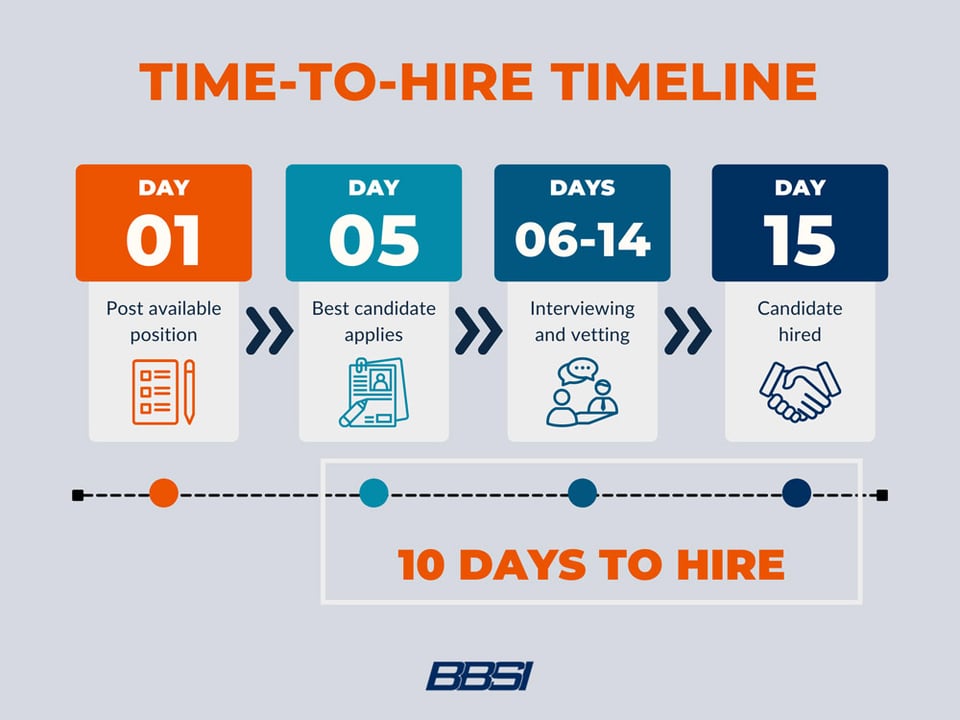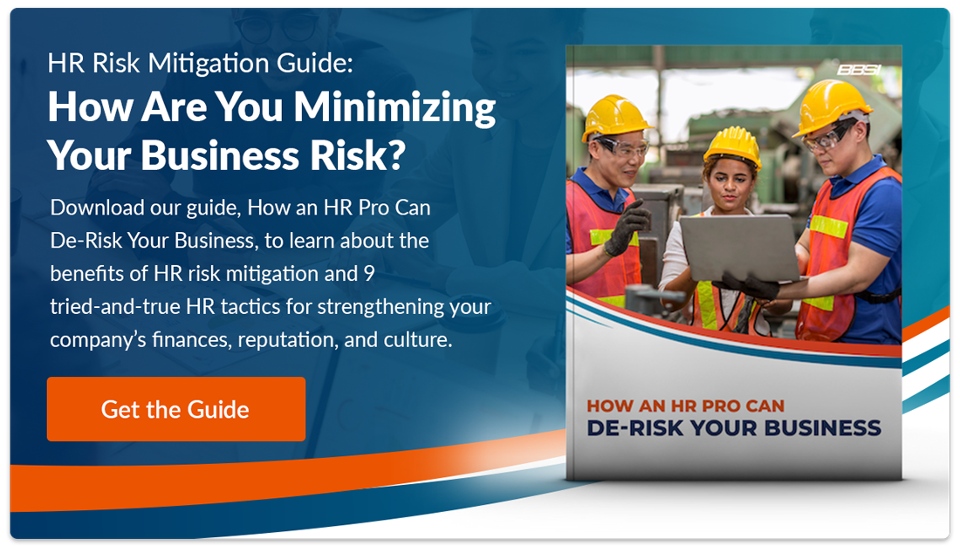
9 Ways to Speed Up Time-to-Hire With Strategic Staffing Solutions
Employee turnover is on everyone's mind these days. With 10.4 million job openings in November 2021, the Great Resignation is leaving businesses in a vulnerable position to fill their vacant roles amidst fierce competition.
In times like these, it's imperative for companies to use strategic staffing solutions to improve their staffing and recruiting process. This will allow them to hire the best talent available before the competition does. Fortunately, there are several ways companies can speed up their time-to-hire and move forward with quality employees quickly.
What is Time-To-Hire?
Time-to-hire is a strategic staffing solution that refers to the amount of time it takes to hire a new employee, beginning from first contact, continuing through the interview process, and culminating when they accept the job offer.
Your time-to-hire metric tracks how quickly you move your desired candidate through the hiring process. For example, if you post an available position and your best candidate applies five days later but isn’t hired until 15 days after the job was posted, your time-to-hire metric is 10.

Time-to-hire is particularly important because it measures the aspects of the hiring process that you control. Tracking your time-to-hire metric benefits your business in multiple ways, including:
- Helping pinpoint bottlenecks in your hiring process
- Telling how quickly your hiring team moves on desirable candidates
- Showing how long it takes your team to spot the right person for a position
To Effectively Manage Employee Turnover, Your Time-To-Hire Can't Be Too Slow
The classic "slow to hire, fast to fire" adage doesn’t apply in a labor market where job applicants hold the bargaining chip. Your prospective employees likely have several companies approaching them, meaning you can't wait a month before contacting a desirable applicant.
Take a look back at your recent hiring endeavors. When you were ready to offer a candidate a position at your company, how often had the candidate already found another job? Each of those candidates represents a missed opportunity to add a great employee to your team. However, each instance also offers a chance to unpack your hiring process and identify the obstacles preventing you from employing the talent you need.
Is it Possible to Have a Time-To-Hire Rate That’s Too Fast?
Yes, it is possible to hire new employees too quickly. When you have vacant positions and work that needs to be done, your HR team must apply proper workforce planning procedures before you go on a hiring spree.
"Slow to hire" still has its place in the modern job market, but don't ignore the red flags. While you may feel pressure to fill roles, hiring a bad fit can cause more problems than having no one in the position at all. Pay close attention to your new hires during their first 90 days. If you see a trend of bad fits in your new recruits, it's time to reevaluate the factors you consider when hiring new employees.
9 Ways Companies Can Speed Up Their Time-To-Hire
Hiring thoroughly vetted, quality employees while remaining efficient can be a difficult tightrope to walk. These steps will help you hire the best candidates before your competition does.
1. Set Clear Expectations
Whether a candidate is employed but actively looking for a new role, or unemployed and searching for an opportunity, they will have their own ideal timeline for moving to a new company. If their timeline or expectations don’t match yours, this will create friction from the get-go.
To help create a more seamless process for both parties, you need to communicate what the candidate should expect from your hiring procedures during the first interaction. If a candidate doesn’t know when (or even if) they'll hear from you next, they may accept another offer instead of waiting for you.
You should also clearly communicate your maximum salary or pay before jumping into the interview process. This will help candidates avoid buyer's remorse after accepting a position, and help you avoid wasted resources courting a candidate you can’t afford.
Because manually managing candidate communication is a huge lift for your HR team, you could consider investing in an automated system to help streamline the process and take some pressure off of your internal resources.

2. Leverage Industry Connections
It's much easier to choose from a small pool of excellent candidates than a large mixed bag. Reach out to your industry connections to see if they can recommend any candidates with a work ethic they can vouch for. Sourcing reliable recommendations can remove weeks from your time-to-hire metric.
3. Start with Phone and Video Interviews
Some of your best candidates may still be working while they look for new opportunities. Their busy schedules won’t allow them to take an hour or two during a workday to meet with you, especially for the first interview.
Meet your candidates halfway and conduct the first interview over the phone or a Zoom call. This allows them to meet with you during their lunch break, and help you reduce your HR team's time commitment during the initial vetting process. If everything feels right for both parties, you can move forward with an in-person interview.
4. Utilize Job Ad Placements
Don't underestimate the effectiveness of a job ad posting; many great candidates look at them regularly. Paying the fee for a job ad placement can be a great investment if done correctly. Research which job boards your desired employees look at before deciding on your ad’s placement.
Social media targeting can also help you find the right people to put your ad in front of. Let social media help you pinpoint the kind of people you're looking for, and it'll make sure they see your job ad.
5. Monitor Your Glassdoor
For many potential employees, your Glassdoor account is their first impression of your company and helps them decide whether or not to apply. Glassdoor not only hosts reviews from past employees but also has a specific section for interviews. There are two big reasons why this matters to you.
First, it gives you insight into how candidates view your interview process. This is a great opportunity for you to make adjustments that make your company more attractive to candidates.
It's also important that you keep an eye out for false information. A disgruntled candidate who didn’t get a job could paint your interview process and company in a bad light, driving away good candidates. Be open to the feedback, but make sure you're not being misrepresented.
6. Limit Your Group of Candidates
Recruiting and hiring isn’t your HR team’s only responsibility. Help keep their workload manageable by starting with three to four potential employees and narrowing it down from there. If you don’t find a perfect match in that wave, bring in another three to four candidates and narrow it down again. You can do this until you find an obvious winner or have a few great candidates you’d like to talk to further.
7. Keep a Bank of Previous Interviewees
Oftentimes you’ll find a handful of good candidates but will only have one position to fill. Keeping in touch with those candidates will help you build a pool of prospective employees who are already familiar with your company so when a new position opens up, you can reach out to them instead of starting the process from square one.
8. Be Strategic About Who's in the Room
While it’s important to include other people in the hiring process, be careful about who you ask to participate in interviews. If someone doesn’t have decision-making or swaying power, they shouldn’t be in the room; otherwise, you add noise that will delay the process. If your CEO insists on meeting potential candidates, schedule interviews when you know the CEO will be around. Limiting the number of interviews will help save the time of everyone involved.

9. Use a PEO or Staffing and Recruiting Agency
Professional employer organizations (PEOs) and staffing agencies make their living seeking, vetting, and hiring good employees for other companies. This year, you may be hiring four employees, but they're hiring four this afternoon. Because these organizations constantly vet and stay in contact with job seekers, they can be the perfect tool to help you recruit the best candidates. If you tell them who you want, they may already have five candidates in mind. This will help you eliminate half of the steps in your hiring process.
An external organization can also offer you a fresh pair of eyes and feedback on your internal process. They've handled more new hires in a year than most companies will in ten, so they've undoubtedly refined their process and know what the best candidates look for in companies. Ask for feedback or help to identify areas of improvement.
Reduce Employee Turnover and Speed Up Your Time-To-Hire with BBSI
BBSI is a PEO dedicated to helping both established and emerging businesses grow and thrive in any economic climate. Our local support team provides direct consultation with business owners in the areas of business process improvement and HR support.
Some BBSI locations also offer strategic staffing solutions. We deliver vetted candidates that will fly through your interview process so you can get back to business. Our staffing and recruiting experts will guide you through the hiring process, offer feedback, equip you with the right interview questions, and help you hire the best candidates on the market.
We pride ourselves in partnering with companies to provide local talent that gets to know their client's business challenges. Contact our specialists to get your company staffed right away.
Disclaimer: The contents of this white-paper/blog have been prepared for educational and information purposes only. Reference to any specific product, service, or company does not constitute or imply its endorsement, recommendation, or favoring by BBSI. This white-paper/blog may include links to external websites which are owned and operated by third parties with no affiliation to BBSI. BBSI does not endorse the content or operators of any linked websites, and does not guarantee the accuracy of information on external websites, nor is it responsible for reliance on such information. The content of this white-paper/blog does not provide legal advice or legal opinions on any specific matters. Transmission of this information is not intended to create, and receipt does not constitute, a lawyer-client relationship between BBSI, the author(s), or the publishers and you. You should not act or refrain from acting on any legal matter based on the content without seeking professional counsel.
